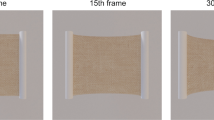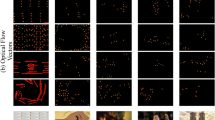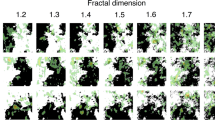Abstract
Video feedback occurs whenever a video camera is directed at a screen displaying the image currently being recorded by the camera. It can be observed in everyday situations, for example at sporting events when a stadium's display screen comes into the camera's view. Here we consider how this simple physical process is affected by the fact that monitors are pixel-based, and show that it can result in stationary fractal patterns such as von-Koch snowflakes and Sierpinski gaskets.
Similar content being viewed by others
Main
Video feedback is a popular scientific phenomenon1,2, mainly because of its 'beautiful and mesmerizing' images3. It was scientifically investigated in the days of scanline-based cameras and monitors4,5 and is often discussed in the context of fractals as an example of a simple feedback process (see ref. 6, for example).
The best known video-feedback phenomenon is perhaps the 'monitor-inside-a-monitor' effect7, which occurs when the overall magnification, M, of the camera–monitor combination is less than one (M < 1), causing the monitor to display a tunnel-like, non-fractal pattern consisting of nested images of itself. Video-feedback set-ups can be modified, for example by using multiple monitors8 or multiple lenses9, in order to produce stationary fractal patterns.
We demonstrate that pixellated, but otherwise unmodified, video feedback with M > 1 can lead to fractal patterns (we dub this the 'monitor-outside-a-monitor' effect). Previous experiments with M > 1 produced non-stationary complex patterns — for example, rapidly rotating planet-like, fractal-looking structures suspected of being connected to pixels10. Pixels were also described as acting like the 'cells' of a cellular automaton, a class of abstract machine capable of producing fractal patterns11, and simulations of video feedback on a matrix model — in which the matrix elements acted like square pixels — produced stationary fractal spirals12.
We predicted that stationary self-similar fractal patterns would be created in pixellated video feedback by analogy with fractal laser modes13. These patterns result from iterated magnification and pixellation of the image: the former successively stretches any structure in the image to M, M2, M3, ... times its original size, whereas the latter continuously adds small-scale structure in the form of the pixel mask. The result is a pattern consisting of the pixel-mask pattern in various sizes. This hallmark of self-similarity is seen in Fig. 1a: the pattern on the monitor is a large rosette consisting of small rosettes; the small rosettes, each comprising seven bright pixels, are magnified and pixellated images of individual pixels, and the large rosette is a magnified and pixellated image of the central small rosette.
a, Basic set-up; the monitor displays an example of a self-similar pattern. b, Simulated video-feedback pattern consisting of pixel-limited Sierpinski gaskets. c, Pattern obtained with a rotated camera pointing at a colour monitor. In all three examples, the red rectangle marks the camera's respective field of view. Additional details can be obtained from the authors.
The detailed shape of the stationary pattern depends on the shape and size of the individual pixels, the geometry of the pixel array, the magnification and the position within the pixel array of the centre of magnification. For example, a magnification M = 2, combined with a centre of magnification midway between three nearest-neighbour pixels in a hexagonal array of circular pixels, can result in a Sierpinski gasket pattern (Fig. 1b).
Another parameter is the rotation angle of the camera with respect to the monitor. Figure 1c shows a pattern recorded with a camera rotated by 45° and a magnification of M ≈ 1.29. The experiment was greatly facilitated by our camera's ability to remove flicker-related effects by averaging over a number of frames. To our knowledge, this pattern, which arises directly from the pixellation of the display monitor, is the first published example of a stationary fractal created by unmodified video feedback.
References
Hofstadter, D. R. in Gödel, Escher, Bach: an Eternal Golden Braid 490–491 (Penguin, Harmondsworth, UK, 1980).
Andersen, M. C. The Ultimate Video Feedback Page, http://www.videofeedback.dk/World/
Cadman, J. Spinning Lights Home Page, http://home.earthlink.net/~spinninglights/
Crutchfield, J. P. Physica D 10, 229–245 (1984).
Crutchfield, J. P. IEEE Trans. Circuits Systems 35, 770–780 (1988).
Peitgen, H.-O., Jürgens, H. & Saupe, D. in Chaos and Fractals: New Frontiers of Science 19–22 (Springer, New York, 1992).
Peitgen, H.-O., Jürgens, H. & Saupe, D. in Chaos and Fractals: New Frontiers of Science 20 (Springer, New York, 1992).
King, P. H. Video Fractal Genesis, http://www.sirius.com/~fringe/feedback/diagrams.html
Courtial, J. & Padgett, M. J. J. Mod. Opt. 47, 1469–1474 (2000).
Goodman-Strauss, C. Fractal Feedback! http://comp.uark.edu/~cgstraus/TV/index.html
Peak, D. & Frame, M. in Chaos Under Control 301 (Freeman, New York, 1994).
Andersen, M. C. & Petersen, J. Simulation of Video Feedback, http://www.videofeedback.dk/vf/ss/sspost.html (1996).
Courtial, J. & Padgett, M. J. Phys. Rev. Lett. 85, 5320–5323 (2000).
Author information
Authors and Affiliations
Corresponding author
Rights and permissions
About this article
Cite this article
Courtial, J., Leach, J. & Padgett, M. Fractals in pixellated video feedback. Nature 414, 864 (2001). https://doi.org/10.1038/414864a
Issue Date:
DOI: https://doi.org/10.1038/414864a
This article is cited by
-
Self-similarity in ultrafast nonlinear optics
Nature Physics (2007)
Comments
By submitting a comment you agree to abide by our Terms and Community Guidelines. If you find something abusive or that does not comply with our terms or guidelines please flag it as inappropriate.




